Respective implications of glutamate decarboxylase antibodies in stiff person syndrome and cerebellar ataxia
- PMID: 21294897
- PMCID: PMC3042903
- DOI: 10.1186/1750-1172-6-3
Respective implications of glutamate decarboxylase antibodies in stiff person syndrome and cerebellar ataxia
Abstract
Background: To investigate whether Stiff-person syndrome (SPS) and cerebellar ataxia (CA) are associated with distinct GAD65-Ab epitope specificities and neuronal effects.
Methods: Purified GAD65-Ab from neurological patients and monoclonal GAD65-Ab with distinct epitope specificities (b78 and b96.11) were administered in vivo to rat cerebellum. Effects of intra-cerebellar administration of GAD65-Ab were determined using neurophysiological and neurochemical methods.
Results: Intra-cerebellar administration of GAD65-Ab from a SPS patient (Ab SPS) impaired the NMDA-mediated turnover of glutamate, but had no effect on NMDA-mediated turnover of glycerol. By contrast, GAD65-Ab from a patient with cerebellar ataxia (Ab CA) markedly decreased the NMDA-mediated turnover of glycerol. Both GAD65-Ab increased the excitability of the spinal cord, as assessed by the F wave/M wave ratios. The administration of BFA, an inhibitor of the recycling of vesicles, followed by high-frequency stimulation of the cerebellum, severely impaired the cerebello-cortical inhibition only when Ab CA was used. Moreover, administration of transcranial direct current stimulation (tDCS) of the motor cortex revealed a strong disinhibition of the motor cortex with Ab CA. Monoclonal antibodies b78 and b96.11 showed distinct effects, with greater effects of b78 in terms of increase of glutamate concentrations, impairment of the adaptation of the motor cortex to repetitive peripheral stimulation, disinhibition of the motor cortex following tDCS, and increase of the F/M ratios. Ab SPS shared antibody characteristics with b78, both in epitope recognition and ability to inhibit enzyme activity, while Ab CA had no effect on GAD65 enzyme activity.
Conclusions: These results suggest that, in vivo, neurological impairments caused by GAD65-Ab could vary according to epitope specificities. These results could explain the different neurological syndromes observed in patients with GAD65-Ab.
Figures
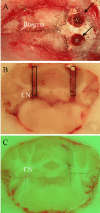

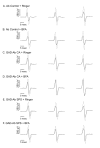

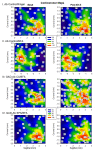

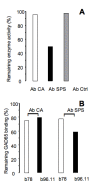
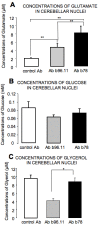



Similar articles
-
Monoclonal antibodies to 65kDa glutamate decarboxylase induce epitope specific effects on motor and cognitive functions in rats.Orphanet J Rare Dis. 2013 Jun 5;8:82. doi: 10.1186/1750-1172-8-82. Orphanet J Rare Dis. 2013. PMID: 23738610 Free PMC article.
-
Cerebellar ataxia and glutamic acid decarboxylase antibodies: immunologic profile and long-term effect of immunotherapy.JAMA Neurol. 2014 Aug;71(8):1009-16. doi: 10.1001/jamaneurol.2014.1011. JAMA Neurol. 2014. PMID: 24934144 Free PMC article.
-
Human Stiff person syndrome IgG-containing high-titer anti-GAD65 autoantibodies induce motor dysfunction in rats.Exp Neurol. 2013 Jan;239:202-9. doi: 10.1016/j.expneurol.2012.10.013. Epub 2012 Oct 23. Exp Neurol. 2013. PMID: 23099416
-
Neurological Syndromes Associated with Anti-GAD Antibodies.Int J Mol Sci. 2020 May 24;21(10):3701. doi: 10.3390/ijms21103701. Int J Mol Sci. 2020. PMID: 32456344 Free PMC article. Review.
-
Stiff-person syndrome associated with cerebellar ataxia and high glutamic acid decarboxylase antibody titer.Intern Med. 2001 Sep;40(9):968-71. doi: 10.2169/internalmedicine.40.968. Intern Med. 2001. PMID: 11579968 Review.
Cited by
-
tDCS of the Cerebellum: Where Do We Stand in 2016? Technical Issues and Critical Review of the Literature.Front Hum Neurosci. 2016 May 11;10:199. doi: 10.3389/fnhum.2016.00199. eCollection 2016. Front Hum Neurosci. 2016. PMID: 27242469 Free PMC article. Review.
-
Paroxysmal Kinesigenic Dyskinesia Symptoms Markedly Reduced with Parenteral Vitamins and Minerals: A Case Report.Perm J. 2019;23:19.036. doi: 10.7812/TPP/19.036. Epub 2019 Oct 3. Perm J. 2019. PMID: 31634116 Free PMC article.
-
Reduced display of conformational epitopes in the N-terminal truncated GAD65 isoform: relevance for people with stiff person syndrome or DQ8/8-positive Type 1 diabetes mellitus.Diabet Med. 2019 Nov;36(11):1375-1383. doi: 10.1111/dme.13827. Epub 2018 Dec 28. Diabet Med. 2019. PMID: 30264481 Free PMC article.
-
Fundamental Mechanisms of Autoantibody-Induced Impairments on Ion Channels and Synapses in Immune-Mediated Cerebellar Ataxias.Int J Mol Sci. 2020 Jul 13;21(14):4936. doi: 10.3390/ijms21144936. Int J Mol Sci. 2020. PMID: 32668612 Free PMC article. Review.
-
Monoclonal antibodies to 65kDa glutamate decarboxylase induce epitope specific effects on motor and cognitive functions in rats.Orphanet J Rare Dis. 2013 Jun 5;8:82. doi: 10.1186/1750-1172-8-82. Orphanet J Rare Dis. 2013. PMID: 23738610 Free PMC article.
References
-
- Honnorat J, Saiz A, Giometto B, Vincent A, Brieva L, de Andres C, Maestre J, Fabien N, Vighetto A, Casamitjana R, Thivolet C, Tavolato B, Antoine J, Trouillas P, Graus F. Cerebellar ataxia with anti-glutamic acid decarboxylase antibodies: study of 14 patients. Arch Neurol. 2001;58(2):225–30. doi: 10.1001/archneur.58.2.225. - DOI - PubMed
-
- Baekkeskov S, Aanstoot HJ, Christgau S, Reetz A, Solimena M, Cascalho M, Folli F, Richter-Olesen H, De Camilli P. Identification of the 64K autoantigen in insulin-dependent diabetes as the GABA-synthesizing enzyme glutamic acid decarboxylase. Nature. 1990;347(6289):151–6. doi: 10.1038/347151a0. - DOI - PubMed
Publication types
MeSH terms
Substances
Grants and funding
LinkOut - more resources
Full Text Sources

